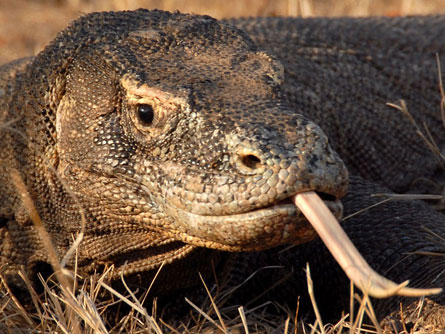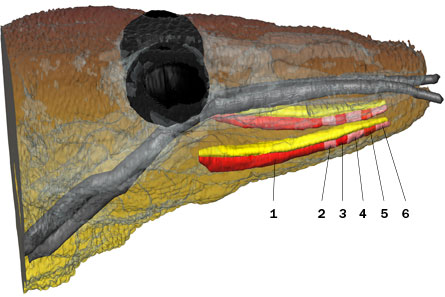World’s largest lizard is venomous too
Komodo dragons kill prey in a way similar to some snakes, scientists find
 |
|
A new study shows Komodo dragons probably use venom, not toxic bacteria, to kill prey.
|
| Chris Kegelman |
If you’re looking for a new pet, don’t even think about a Komodo dragon. These reptiles are the world’s largest lizards and can grow to be 10 feet long and weigh more than 300 pounds. (Roughly the weight of two or three eighth-graders.) Komodo dragons run fast and eat almost any kind of meat, including dead animals, other Komodo dragons and people who get too close. “These things are incredible killing machines,” says Bryan Fry, a biologist and expert on animal venom.
If those reasons aren’t good enough, consider the bite of a Komodo dragon. According to a new study, it may kill prey like snakes by injecting venom. This chemical, according to Fry and his team of scientists at the University of Melbourne in Australia, can cause shock in the unlucky victim. A person or animal goes into shock when the body cannot deliver enough blood to the organs to keep functioning. As a result, the body starts to shut down.
Scientists have only recently begun to understand why a Komodo dragon is so lethal. Some people used to believe that a Komodo dragon’s bite contained bacteria from the mouth that would cause a severe infection in the victim’s blood. The infection would eventually kill the animal, but it could take days. Until then, the Komodo dragon would follow the wounded animal.
Fry calls that story a fairy tale. He says that after being bitten by a Komodo dragon, animals usually die quickly. “No one’s actually seen a Komodo dragon track a prey for three days until it dies,” he says. Plus, he says the Komodo dragon’s mouth doesn’t contain more bacteria than other animals in the wild.
 |
|
Scientists recently discovered Komodo dragons possess six venom glands on each side of the lower jaw.
|
| Bryan Fry, et al. |
To study the giant lizards, Fry and his team used a tool called an MRI, which is often used to study diseases in human beings. MRI stands for magnetic resonance imaging. During the MRI procedure, the head of a Komodo dragon was placed in a powerful magnetic field. The magnetic field caused tiny vibrations in the atoms inside the lizard’s head, and the vibrations allowed Fry and his team to take three-dimensional pictures.
These pictures showed that the lizard has six venom glands on each side of the lower jaw. Combined, these glands can hold about 1.2 milliliters of venom. “It’s astounding,” Fry says. “It was just jaw dropping when we got the first MRI results.”
After more studies, Fry and his team found that the Komodo dragon venom contained some of the same ingredients as snake venom. These ingredients thin the blood and cause blood vessels to become larger — a recipe for shock. To test the venom, the scientists injected rats with it and observed that the rats became still.
Fry’s work shows that Komodo dragons kill their prey with venom, and not by germs — and gives us another reason to steer clear of these giant lizards. That should be easy to do, since they live only on a few islands in the tropical country of Indonesia.
Power words: (from the Yahoo! Kids Dictionary and Britannica.com)
Venom: A poisonous secretion of an animal, such as a snake, spider or scorpion, usually transmitted by a bite or sting.
shock: A potentially fatal physiological reaction to a variety of conditions, including illness, injury, hemorrhage and dehydration, usually characterized by marked loss of blood pressure, diminished blood circulation and inadequate blood flow to the tissues.
MRI: (magnetic resonance imaging) Three-dimensional imaging technique used to visualize organs and structures inside the body without the need for X-rays or other radiation.
Going Deeper:







